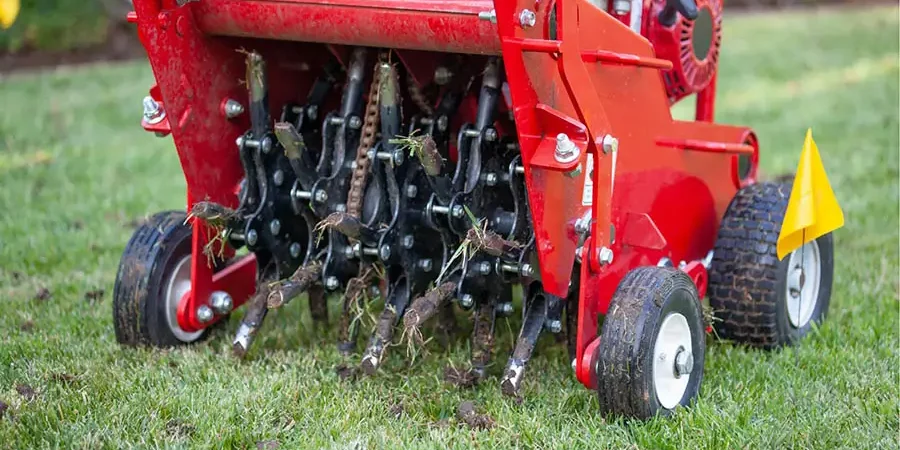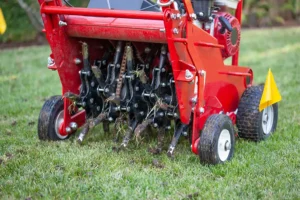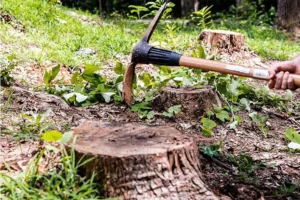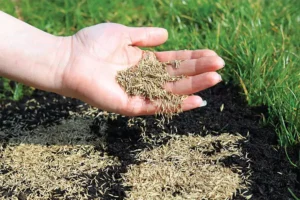Lawn aeration in Omaha, NE sounds simple—poke some holes, pull out small plugs, and watch your grass breathe again. But there’s one sneaky detail that can make or break the results: soil moisture. Doing aeration at the wrong moisture level can turn a great lawn care plan into a messy (and expensive) headache.
Let’s talk about what happens when things go wrong—and how to prepare for the best results possible.
Why Does Soil Moisture Matter So Much for Aeration?
When you aerate your lawn, you’re creating holes or removing small plugs from the soil so air, water, and nutrients can reach the root system of your lawn. This process is what keeps your grass strong and healthy, especially in compact soil. But the success of this process depends on the soil being just right—not too dry, not too soggy.
Too Dry: The aerator can’t dig deep enough. You’ll end up scratching the surface without helping the roots.
Too Wet: The soil turns mushy, plugs clump together, and you can damage your turf.
Finding that middle ground gives your aeration and overseeding service the best chance to work properly.
What Happens When You Aerate in Dry Soil?
Tough on Equipment and Turf
When the soil is bone dry, it’s like trying to dig into concrete. Your aeration equipment has to work overtime, which can cause wear and tear on specialized equipment and pull shallow cores that don’t do much good.
Shallow Holes Mean Shallow Results
When the holes aren’t deep enough, your roots can’t breathe well, water won’t reach where it needs to, and fertilizer won’t soak in properly.
Soil Compaction Stays Put
If your soil is compact, dry aeration barely helps. The plugs that come out are often tiny or crumbly, meaning your lawn gets no real benefit.
Overseeding Struggles
If you plan to pair aeration with overseeding, dry soil makes it hard for new grass seed to germinate and grow. Seeds just sit on top, waiting for moisture that never comes.
I made the mistake of scheduling aeration when my lawn’s soil was completely dried out. The machine struggled to pull proper cores—it felt like trying to drill into concrete. The holes ended up shallow, the plugs crumbled instantly, and my overseeding never took root.
The grass seed just sat on top of the hard ground waiting for moisture that never came, and the soil compaction barely improved. That’s when I decided to work with ShurLawn & Landscape. Their team explained why proper soil moisture is crucial before aeration.
They scheduled the service right after a good soaking rain, which allowed them to pull deep, healthy cores and create perfect conditions for overseeding. Within weeks, the lawn was thicker, greener, and finally breathing again.
— Tom, Maple Street
What Happens When You Aerate in Wet Soil?
A Sloppy Mess That Damages Turf
Aerating when the soil is too wet can cause a whole different set of problems. While it might seem like soft soil makes it easier to pull plugs, soggy conditions can actually harm your turf health.
Soil Smearing Happens
When wet soil sticks to the plugs and the holes’ edges, it smears instead of breaking apart cleanly. This prevents air and water from moving through the soil properly.
Root System Suffers
A muddy lawn can suffocate the root system of your lawn. The holes may fill back up too quickly, undoing the aeration work.
Heavy Equipment Damage
Professional lawn aeration service machines are powerful, and when used on wet turf, they can leave deep tracks or even tear parts of your lawn.
How Can You Tell If Your Soil Is at the Right Moisture Level?
The Simple Hand Test
You don’t need fancy tools to check. Just grab a small handful of soil from your Omaha lawn.
- If it crumbles apart easily, it’s too dry.
- If it squishes like mud, it’s too wet.
- If it holds together but breaks apart gently, it’s just right.
That’s the sweet spot for core aeration and overseeding.
Timing Matters
In Omaha and Elkhorn, the best time to aerate is usually in the fall when the soil is moist from seasonal rain but not soaked. Fall aeration helps your lawn recover from summer heat stress and prepares it for lush spring growth.
How to Prepare for Proper Lawn Aeration in Omaha, NE
Getting ready for a professional lawn aeration service means more than just booking an appointment. Proper preparation gives your lawn the best results.
- Water Your Lawn Before Aeration: Water your lawn one or two days before the service to loosen the soil, but avoid soaking it. This helps the aerator pull out clean, deep plugs.
- Avoid Aerating After Heavy Rain: Wet soil can lead to compacting instead of loosening, which defeats the whole purpose.
- Mow Regularly: A freshly mowed lawn makes it easier for the aeration equipment to do its job. Regular mowing also helps new grass seed spread evenly afterward.
- Mark Sprinkler Heads and Irrigation Lines: Protect your sprinkler system by marking where heads or lines are located. It’s an easy way to prevent damage during aeration.
- Combine Aeration and Overseeding: Fall lawn aeration paired with overseeding fills those fresh holes with new grass seed, helping to thicken thin spots and promote a greener, stronger turf.
What Are the Results of Aerating Under the Wrong Conditions?
When aeration happens under bad soil moisture, your Omaha lawn may look the same—or worse.
Uneven Holes
Dry or muddy soil makes it hard for the machine to pull even plugs, leaving patchy holes across your turf.
Stagnant Lawn Growth
Without proper aeration, the root system stays weak, and you’ll notice slow or uneven lawn growth.
Wasted Effort
Fertilizer, water, and grass seed may not reach the roots, wasting your time and money.
Damage to Turf
In wet conditions, the machine’s weight can create ruts or flatten healthy grass, affecting lawn health long-term.
What’s the Best Way to Fix a Poor Aeration Job?
If your aeration service in Omaha didn’t go as planned, don’t panic. There are ways to help your lawn recover.
- Let It Dry Out: If your soil is too wet, let the area dry before doing any more lawn treatments.
- Re-Aerate at the Right Moisture Level: Once the soil reaches the right condition, aerate again using professional equipment.
- Add Overseeding and Fertilizer: This helps fill in damaged or bare areas, giving your turf a second chance at healthy growth.
- Plan for Fall Aeration: For seriously compacted lawns, annual fall overseeding and aeration help rebuild the root structure over time.
Frequently Asked Questions About Aeration Under the Wrong Soil
1. Can I aerate my lawn if it rained the night before?
It’s best to wait a day or two after heavy rain. Too much water makes the soil muddy, which can harm your turf and reduce aeration effectiveness.
2. Should I water my lawn before aeration?
Yes, lightly water your lawn a day before. Moist soil allows small plugs from the soil to pull out cleanly without turning muddy.
3. How often should I schedule lawn aeration in Omaha?
Once a year is usually enough. But seriously, compacted lawns or heavy-traffic areas may need aeration twice a year for better root growth and greener grass.
Conclusion
Getting the best lawn in Omaha isn’t just about mowing and watering. Timing, preparation, and soil moisture play a huge role in how well your lawn aeration service works. Avoid aerating when it’s too dry or too wet, and aim for those ideal conditions to give your turf a healthy boost.
If you want your Omaha lawn to look its best, contact ShurLawn & Landscape at 402-572-0710. Our professional aeration and overseeding service uses the right equipment and timing to bring new life into your lawn.




